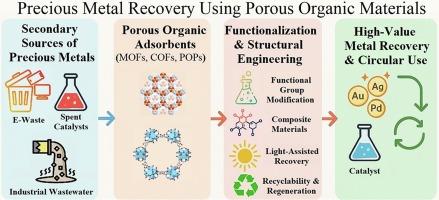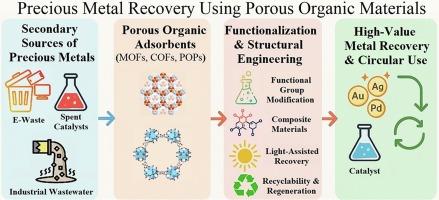利用多孔有机材料回收贵金属的最新进展:从结构到机制
IF 23.5
1区 化学
Q1 CHEMISTRY, INORGANIC & NUCLEAR
引用次数: 0
摘要
由于贵金属的资源稀缺性、经济价值以及与电子废物(电子废物)相关的日益严重的环境问题,从二次资源中回收贵金属(pm)变得越来越重要。本文综述了金属有机骨架(MOFs)、共价有机骨架(COFs)、多孔有机聚合物(POPs)等吸附剂在回收电子垃圾渗滤液和工业废水等二次资源中PM的最新研究进展。这些材料由于其大的表面积、可调的孔隙结构和多样化的功能化能力而引起了人们的极大关注。本文综述了这些材料在提取金、银、钯、铂等金属中的结构特点、吸附性能、选择性和再生能力。进一步探讨了关键吸附机理。最后,讨论了该领域目前面临的挑战,并强调了未来的研究方向,强调需要开发更具选择性,稳定性和可重复使用的吸附剂,以及探索混合技术和机器学习方法。通过总结目前的研究趋势和识别知识空白,本文旨在指导更高效的多孔吸附剂的开发,促进循环经济框架下的可持续资源管理。本文章由计算机程序翻译,如有差异,请以英文原文为准。


Recent advances in precious metal recovery using porous organic materials: from structure to mechanisms
The recovery of precious metals (PMs) from secondary resources has become increasingly crucial due to their resource scarcity, economic value, and the growing environmental concerns associated with electronic waste (e-waste). This review provides an overview of the latest research advancements in the application of metal-organic frameworks (MOFs), covalent-organic frameworks (COFs), and porous organic polymers (POPs), adsorbents for PM recovery from secondary resources such as e-waste leachate and industrial effluents. These materials have garnered significant attention due to their large surface areas, tunable pore structures, and diverse functionalization capabilities. This review delves into the structural characteristics, adsorption performance, selectivity, and regeneration capabilities of these materials for extracting PMs such as gold, silver, palladium, and platinum. Furthermore, key adsorption mechanisms are explored. Finally, current challenges in the field are discussed, and future research directions are highlighted, emphasizing the need to develop more selective, stable, and reusable sorbents, as well as exploring hybrid technologies and machine learning approaches. By summarizing current research trends and identifying knowledge gaps, this article aims to guide the development of more efficient porous adsorbents and promote sustainable resource management within the circular economy framework.
求助全文
通过发布文献求助,成功后即可免费获取论文全文。
去求助
来源期刊

Coordination Chemistry Reviews
化学-无机化学与核化学
CiteScore
34.30
自引率
5.30%
发文量
457
审稿时长
54 days
期刊介绍:
Coordination Chemistry Reviews offers rapid publication of review articles on current and significant topics in coordination chemistry, encompassing organometallic, supramolecular, theoretical, and bioinorganic chemistry. It also covers catalysis, materials chemistry, and metal-organic frameworks from a coordination chemistry perspective. Reviews summarize recent developments or discuss specific techniques, welcoming contributions from both established and emerging researchers.
The journal releases special issues on timely subjects, including those featuring contributions from specific regions or conferences. Occasional full-length book articles are also featured. Additionally, special volumes cover annual reviews of main group chemistry, transition metal group chemistry, and organometallic chemistry. These comprehensive reviews are vital resources for those engaged in coordination chemistry, further establishing Coordination Chemistry Reviews as a hub for insightful surveys in inorganic and physical inorganic chemistry.
 求助内容:
求助内容: 应助结果提醒方式:
应助结果提醒方式:


